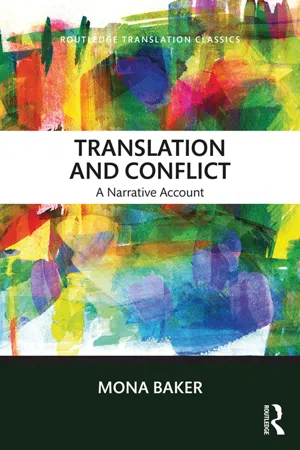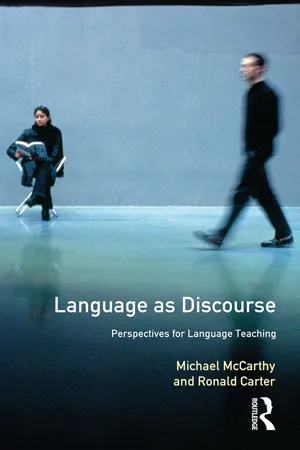Narrative Discourse
Narrative discourse refers to the way a story is told, including the structure, style, and techniques used by the author to convey the narrative. It encompasses the organization of events, the point of view, and the overall presentation of the story. Narrative discourse plays a crucial role in shaping the reader's experience and understanding of the literary work.
6 Key excerpts on "Narrative Discourse"
- eBook - ePub
Researching Interpretive Talk Around Literary Narrative Texts
Shared Novel Reading
- John Gordon(Author)
- 2020(Publication Date)
- Routledge(Publisher)
...Narrative provides a lens by which insight may be gained. Narrative analysis is inherently interdisciplinary, given its origins in literary and cultural theory, and consequently attends to the detail of texts no matter what their medium of presentation. Since the late twentieth century the adoption of narrative analysis in social science has been concurrent with the growing popularity of qualitative methods attentive ‘to language, to the biographical, to the unconscious, to participant-centred research, to ecological research, to the social (in psychology), to the visual (in sociology and anthropology), to power, to culture, to reflexivity’ (Squire, 2008, p.6). The narrative turn refracts each of these. If narrative analysis is this versatile, having relevance across disciplines, it can also turn in on itself, to examine the place of given narratives embedded in further narration – and across the modalities of print and speech that characterise literary study classrooms. The researcher adopting methods of narrative analysis can legitimately attend to textual structures, content, performance and contexts simultaneously. In such an endeavour, the education researcher of literary study will find the syntactic/ structural models of narratology useful for considering the nature of the study text as it is experienced in print. They will also be helped by pragmatic theories of narration as performance, such as the experience-centred approaches to narrative (Mishler, 1986) used extensively in other strands of contemporary social science research. These are interested in the experiences of both speakers of tales and their audiences but surprisingly have had limited take-up in education research, even though narration is a core activity in pedagogy across phases and subjects, whether or not, obviously, narrative forms such as literary fiction are central to the immediate teaching purpose...
- eBook - ePub
Translation and Conflict
A narrative account
- Mona Baker(Author)
- 2018(Publication Date)
- Routledge(Publisher)
...2 Introducing narrative theory The notion of narrative has attracted much attention in a wide range of disciplines, and has accordingly been defined in a variety of ways. This chapter will draw primarily on social and communication theory to elaborate a definition of narrative that is particularly suited to investigating the way in which translators and interpreters function in situations of conflict. I start with an overview of the status and effects of narrativity, including its relationship to genres, science, categories, fact and fiction, and conclude with a discussion of the political import of narratives and the way in which narrative both reproduces existing power structures and provides a means of contesting them. 2.1 The status and effects of narrativity Many scholars, especially in literary studies and linguistics, tend to treat narrative as an optional mode of communication, often contrasting it with argumentation or exposition. Approaches that treat narrative as an optional mode tend to focus on the internal structure of orally delivered or literary narratives – in terms of phases, episodes and plots, for instance – and to stress the advantages of using narrative, rather than other modes of communication, to secure the audience’s commitment and involvement. The best and most influential example of this tradition is Labov. A very brief summary of his approach might help clarify important differences between literary and linguistic approaches to narrative and the broadly sociological approach adopted in this book. Labov defines narrative as ‘ one method of recapitulating past experience by matching a verbal sequence of clauses to the sequence of events which (it is inferred) actually occurred’ (1972: 359–60; emphasis added), and what he calls a ‘ minimal narrative ’ as ‘a sequence of two clauses which are temporally ordered ’ (1972: 360; emphasis in original)...
- eBook - ePub
Language as Discourse
Perspectives for Language Teaching
- Michael Mccarthy, Ronald Carter(Authors)
- 2014(Publication Date)
- Routledge(Publisher)
...Increasingly, literary texts are becoming a subject for discourse analysis; indeed, the term discourse stylistics now refers to the practice of using discourse analysis in the study of literary texts (see Carter and Simpson 1989: 11). Through a contextually oriented approach of this kind much can be revealed: for example, the relationships between characters in novels and plays; the nature of the spoken voice in both prose and poetry; patterns in narrative organization; the differences and similarities between literary and non-literary texts as social discourse in contexts of use. This approach also means that questions concerning the relationship between language and culture cannot be ignored. Such questions naturally lead us to consider the relationship between language, text and ideology. In turn, discourse analysis cannot really avoid the question: what is literature? Such questions also have important implications for the use of literature in the classroom, especially in the context of language teaching. Answers to these questions affect the criteria for the division of the world of discourse which was the subject of Chapter 1, the subsequent selection of texts for the syllabus, the sequence in which they are studied, teaching methodology and the nature of the literature curriculum. 4.1 Conversational analysis: pragmatics and style Two good starting-points for the analysis of literary discourse are fictional and drama dialogue since the functions of such stretches of language normally require explanation by reference to language organization beyond the sentence or the single conversational turn. Quite often, this will involve ‘making sense’ of language which on the surface appears to make no sense at all. Modern dramatists, in particular, draw extensively on such patterns of discourse. For example, the famous ending of Waiting for Godot by Samuel Beckett (1956): VLADIMIR: Well. Shall we go? ESTRAGON: Yes...
- eBook - ePub
- Yoko Hasegawa(Author)
- 2013(Publication Date)
- Routledge(Publisher)
...The norms governing all types of letter writing, as one example, vary considerably from language to language and from period to period. “Hence a woman writing to a friend in 1812 would no more have signed her letters with love …as a contemporary English woman might, any more than an Italian would conclude letters without a series of formal greetings to the recipient of the letter and his relations. In these cases,…the translator decodes and attempts to encode pragmatically” (Bassnett 1980/2002: 34). A translation normally results in a text of the same genre as the original. That is, a narrative ST needs to be translated as a narrative in the TT; it should not sound, for example, like an expository text. For this, one needs to be able to recognize differences among genres. Many attempts have been made to establish a classification system of discourse genres. Larson (1984: 365–80), for example, identified six types: narrative, procedural, expository, descriptive, hortatory, and repartee. A given discourse typically contains a number of different basic genres: a narrative opens with a location description, but in most cases, one characteristic stands out as dominant. 4.1. Narrative Discourse 4.1.1. General Characteristics Narrative Discourse is the recounting of chains of real or fictional events, such as seen in biographies, folk stories, historical chronicles, memoirs, mythology, and personal accounts. In English, the text is normally and consistently in the past tense, typically in chronological order, and told in either the first- or third-person singular. Here are excerpts from Lewis Carroll’s fantasy Alice’s Adventures in Wonderland (first published in 1865) and its translation by Y AGAWA Sumiko. Alice was not a bit hurt, and she jumped up on to her feet in a moment: she looked up, but it was all dark overhead: before her was another long passage, and the White Rabbit was still in sight, hurrying down it...
- eBook - ePub
- David Herman(Author)
- 2011(Publication Date)
- Wiley-Blackwell(Publisher)
...Although more needs to be done to promote genuine dialogue and exchange among story analysts working in different fields (Hyvärinen 2006), it is undeniable that the past decade in particular has seen an exponential growth of cross-disciplinary research and teaching activity centering around narrative. International in scope, this activity has also spawned book series and journals in which scholarship on narrative figures importantly. 2 Other manifestations of the way narrative cuts across disciplinary boundaries include initiatives such as the Centre for Interdisciplinary Narratology at the University of Hamburg (< http://www.icn.uni-hamburg.de >); the Centre for Narrative Research at the University of East London (< http://www.uel.ac.uk/cnr/ >); Columbia University’s Program in Narrative Medicine (< http://www.narrativemedicine.org/ >), which aims “to fortify medicine with ways of knowing about singular persons available through a study of humanities, especially literary studies and creative writing”; and Project Narrative at Ohio State University (< http://projectnarrative.osu.edu >), which brings together folklorists, scholars of language and literature, theorists of storytelling in film, digital media, and comics and graphic novels, and researchers in other fields concerned with narrative. During the same period, a number of conferences and symposia have been convened to explore the potential of narrative to bridge disciplines, in ways that may in turn throw new light on narrative itself. 3 The present book, which explores basic elements of narrative and examines how those elements manifest themselves in various kinds of storytelling media and communicative situations, can be seen as an outgrowth of this same trend toward interdisciplinarity (and transmediality) in narrative research (cf...
- eBook - ePub
Narrative
A Critical Linguistic Introduction
- Michael Toolan(Author)
- 2012(Publication Date)
- Routledge(Publisher)
...Among the many narrative tasks Free Indirect Discourse can help perform are ironies and mismatches of the kind found in the commentary on Isabel above; equally, it can be used in the service of empathetic disclosure as in the depiction of Ralph or, in the earlier passage, Bertha. Wherever it is employed, it seems to involve subtlety and complexity and demands a commensurate care from the reader. Note, for example, how despite Isabel’s insistence on her own patience towards Ralph, her indulgence, her refusal ‘to resent his want of sympathy’, she does resent his unspoken reservations and wearies of waiting. Or, somewhat differently, consider the narrator’s clever collusion with the reader – ‘We, who know more about poor Ralph than his cousin’ – when he picks up Isabel’s complaint that ‘he might at least go through the form’ (i.e. wishing her joy and happiness, etc.), and uses the same phrase in the next sentence in a tellingly different sense. 5.2 Modes of speech and thought presentation We should begin with fundamental principles. When a narrator sets about telling some individual’s story, there will be various actions and events involving the character, which they will wish to narrate. Where these actions are physically overt and observable by any careful witness – She sat at the window watching the evening invade the avenue – I call these Pure Narrative sentences. Very often, exercising their option to be as revealing of a character’s inward feelings as they wish (the narratorial option to disclose ‘up to omniscience’), information that goes beyond external witnessing will be related: in her nostrils was the odour of dusty cretonne. As long as those inward details remain matters of which the character is not consciously aware, I would still call them part of the Pure Narrative (PN)...





